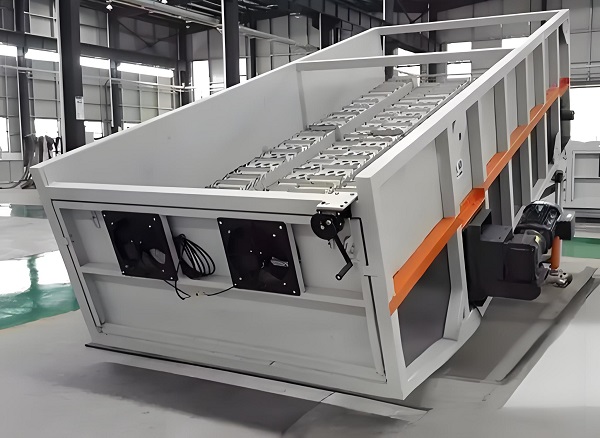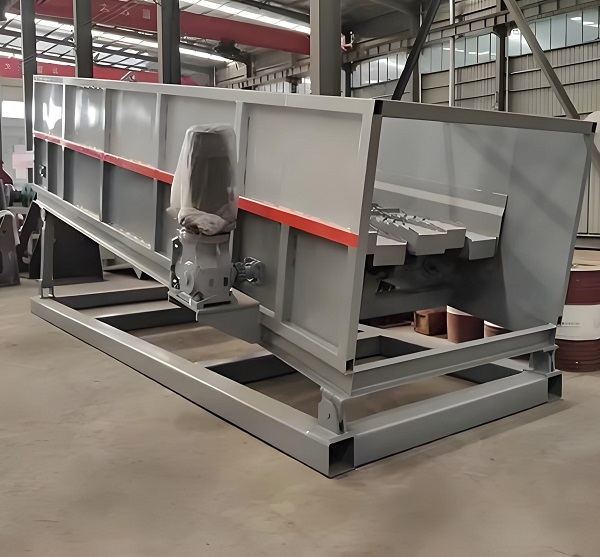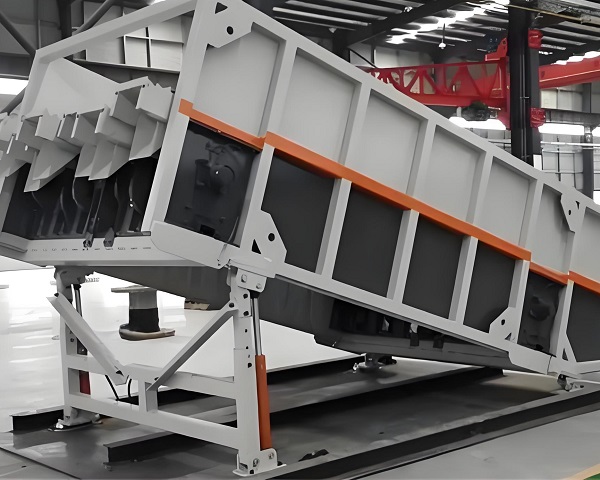In solid waste resource recovery systems, the ballistic screen, leveraging its vibrating and rebounding separation principle, has become a core device for coarse and graded material separation. With tightening environmental standards and increasing demand for resource recovery, traditional pop-up screens are facing increasing challenges, such as clogging and poor adaptability. Technological upgrades are urgently needed. This article focuses on the current state of pop-up screen technology, analyzing breakthroughs in structural innovation and application scenarios. It also offers insights into developments in intelligentization and environmental protection, providing a reference for the industry to understand its technological value.
As a core device in solid waste sorting, the ballistic screen, leveraging its unique "vibrating and rebounding separation" principle, performs critical coarse and graded tasks in scenarios such as municipal waste pretreatment and construction waste recycling. Its technological development has consistently centered around three core objectives: improved efficiency, enhanced adaptability, and enhanced environmental protection. Currently, it has developed a multi-structure adaptable, multi-scenario application landscape, and is rapidly evolving towards intelligentization and refinement. The following systematically analyzes the current state of pop-up screen technology and development trends, combining technological breakthroughs with industry needs.
Technology Status: Mature Applications Resulting from Structural Iteration and Performance Upgrades

Currently, pop-up screen technology has transcended the limitations of traditional screening equipment, achieving significant improvements in structural design, sorting efficiency, and adaptability, making it the preferred equipment for solid waste treatment in various fields.
1. Core Structural Innovation Overcomes Traditional Pain Points
Preventing material bounce and achieving efficient separation are key technological breakthroughs. To address the problem of material bounce during screening of high-hardness materials, the new pop-up screen utilizes a fully enclosed hood design with flexible sealing strips to prevent material splashing. This allows the device to adjust the bounce force according to sorting requirements, improving sorting efficiency by over 20%. Regarding the drive system, mainstream equipment utilizes multiple independent pop-up bridges driven by an eccentric shaft. The staggered motion and height difference of adjacent bridges enable directional sorting, pushing light materials forward and separating heavy materials backward. For example, when separating plastic bottles from bricks and stones, separation purity can reach over 90%. Screen surface technology has been simultaneously upgraded. The elastic screen surface combines high-frequency, low-amplitude vibration to reduce sticky material adhesion and adapt to different material characteristics through varying vibration frequencies (typically adjustable from 10-30Hz). This reduces clogging by 80% compared to traditional screen surfaces.
2. Significantly Improved Performance Parameters and Adaptability
Processing efficiency and sorting accuracy have become core competitive indicators. Currently, mainstream spring screens can process 80-150 tons/hour on a single unit. In a rural waste treatment project in Nanchong, a spring screen capable of processing 150 tons per hour, in conjunction with a bag breaker and air separator, achieved a waste reduction rate exceeding 80%. In terms of sorting capabilities, the equipment achieves multi-dimensional material separation: it can separate light combustibles (plastics, paper) from heavy inorganic materials (bricks, stones, metals) based on density, and distinguish between two-dimensional flat materials (films, cardboard) and three-dimensional materials (bottles, cans, hard plastics) based on their form, reducing the burden of subsequent fine sorting by over 60%. Material compatibility has been further expanded. To address the corrosive nature of domestic waste, the screen surface uses 304 stainless steel. To address the high wear of construction waste, a high-manganese steel composite material is used, extending its service life by 2-3 times compared to ordinary steel.
3. A multi-scenario application landscape has been established.
Environmental solid waste treatment has become a major application area. In the pre-treatment of municipal domestic waste, the spring screen, as the first sorting device, can quickly separate food waste, recyclables, and inert residues. After adopting this device at a waste treatment plant in Chengdu, the wear rate of the subsequent incinerator was reduced by 30%. For construction waste sorting, the shaftless ballistic screen can process mixed materials with concrete blocks and rebar up to 300mm in diameter. Its center-shaftless design prevents rebar entanglement and allows for a daily processing capacity of up to 500 tons/hour. Furthermore, miniaturized spring screens are rapidly gaining popularity in rural waste treatment and industrial waste recycling. Their compact structure fits within confined spaces, and their intelligent control system automatically adjusts parameters based on material changes. Each device requires only one inspector.
Development Trend: The Convergence of Intelligence, Environmental Protection, and Integration

With the increasing demand for solid waste resource utilization and increasingly stringent environmental protection standards, spring screen technology is making breakthroughs in three key areas: intelligent control, green operation, and system integration, further expanding its application boundaries.
1. Intelligent Upgrades Enable Precise Control and Efficient Operation and Maintenance
IoT and AI technologies are deeply integrated into equipment operation. In the future, ballistic screen will generally be equipped with a multi-dimensional sensor network to monitor parameters such as vibration frequency, screen surface wear, and material flow in real time, enabling remote monitoring and parameter optimization via an IoT platform. The application of intelligent algorithms enables adaptive adjustment capabilities: when the proportion of food waste in the feed increases, the system automatically reduces the vibration frequency and activates a hot air drying module (50-60°C) to reduce viscosity. When large impurities are detected, a pneumatic baffle is triggered to automatically remove them, increasing sorting accuracy to over 95%. Simultaneously advancing intelligent operation and maintenance, the equipment uses vibration data analysis to provide fault warnings. Remote diagnostics can reduce fault response time to within 2 hours, improving efficiency by 70% compared to traditional operation and maintenance.
2. Environmentally friendly design meets stringent standards
Low pollution and sustainability are key priorities in technological upgrades. For dust control, a fully enclosed enclosure combined with a negative pressure dust collection system keeps dust concentrations below 5mg/m³ during operation, complying with the "Comprehensive Emission Standards for Air Pollutants." Furthermore, the inner surface of the enclosure is sprayed with a polytetrafluoroethylene anti-stick coating, which reduces residual material to less than 1%, minimizing odor. Energy-saving technologies are widely utilized, with permanent magnet synchronous motors replacing traditional asynchronous motors, reducing energy consumption by 20%-30%. Based on a 10-hour daily operation, a single unit saves over 12,000 kWh of electricity annually. Material environmental friendliness is further enhanced, with the use of green components such as biodegradable grease and recycled plastic enclosures, resulting in a recyclable rate of over 80% upon decommissioning.
3. Integration and customization expand the boundaries of application
The synergy between equipment and systems continues to grow. In the future, the ballistic screen will focus more on interconnected design with upstream and downstream equipment. A central control system will be used to coordinate parameters with bag breakers, spiral screens, and air separators. For example, as the pop-up screen separates more light material, the air separator automatically increases air volume, forming a closed-loop control system of "feeding-sorting-recycling." Customized solutions are also being extended to specific sectors: for the high moisture content of stale waste, a pop-up screen with a dehydration module has been developed; for the corrosive nature of hazardous waste, a plastic-lined housing and acid- and alkali-resistant screen surface are used; and for food processing waste, a stainless steel model that meets GMP standards and supports CIP (closed-in-place cleaning) is designed. Furthermore, the modular design allows for rapid disassembly and transportation, making it suitable for installation in remote locations such as mines and rural areas.

Ballistic screen technology has evolved from traditional screening equipment to the "sorting hub" of solid waste treatment systems. Its current structural innovations and performance breakthroughs effectively solve the challenge of efficiently separating multiple types of materials. In the future, with the in-depth application of intelligent technology, the continued drive towards environmental standards, and the growing demand for integration, pop-up screens will evolve from "single sorting equipment" to "intelligent sorting units." Driven by the dual impetus of increasing waste recycling rates and achieving the dual carbon goals, pop-up screens, with their precise control, green operation, and system adaptability, will play a more core role in the solid waste treatment industry, providing key technical support for the development of a circular economy.
Currently, ballistic screen have established a mature application landscape through structural innovation and performance upgrades, achieving efficient sorting in multiple solid waste treatment scenarios. In the future, they will evolve towards intelligent, precise control, environmentally friendly, green operation, and integrated system adaptability, completing the transition from a single device to an intelligent sorting unit. This technological upgrade not only addresses industry pain points but also contributes to increasing waste recycling rates and achieving the dual carbon goals, providing key equipment support for the circular economy.
Save Time! Get A Detailed Quotation Quickly.
